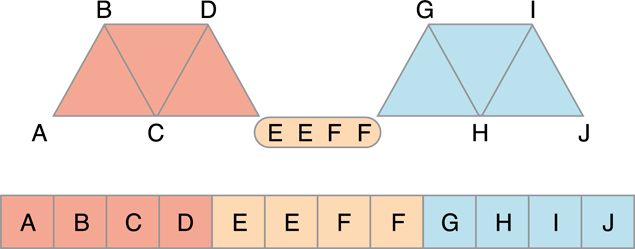Tutorial
GL_TRIANGLE_STRIP
degenerate triangles
.......
What do we need to put in between, in order to link up the triangles? We’ll need an even number of new triangles in order to preserve the winding. We can do this by repeating the last vertex of the first row, and the first vertex of the second row. Here’s the new index buffer below, with the duplicated vertices in bold:
.......
Use Triangle Strips to Batch Vertex Data
Using triangle strips significantly reduces the number of vertex calculations that OpenGL ES must perform on your models. On the left side of Figure 8-5, three triangles are specified using a total of nine vertices. C, E and G actually specify the same vertex! By specifying the data as a triangle strip, you can reduce the number of vertices from nine to five.

Sometimes, your app can combine more than one triangle strip into a single larger triangle strip. All of the strips must share the same rendering requirements. This means:
- You must use the same shader to draw all of the triangle strips.
- You must be able to render all of the triangle strips without changing any OpenGL state.
- The triangle strips must share the same vertex attributes.
To merge two triangle strips, duplicate the last vertex of the first strip and the first vertex of the second strip, as shown in Figure 8-6. When this strip is submitted to OpenGL ES, triangles DEE, EEF, EFF, and FFG are considered degenerate and not processed or rasterized.

For best performance, your models should be submitted as a single indexed triangle strip. To avoid specifying data for the same vertex multiple times in the vertex buffer, use a separate index buffer and draw the triangle strip using the
glDrawElements function (or the glDrawElementsInstanced or glDrawRangeElements functions, if appropriate).
In OpenGL ES 3.0, you can use the primitive restart feature to merge triangle strips without using degenerate triangles. When this feature is enabled, OpenGL ES treats the largest possible value in an index buffer as a command to finish one triangle strip and start another. Listing 8-1 demonstrates this approach.
Listing 8-1 Using primitive restart in OpenGL ES 3.0
// Prepare index buffer data (not shown: vertex buffer data, loading vertex and index buffers)
|
GLushort indexData[11] = {
|
0, 1, 2, 3, 4, // triangle strip ABCDE
|
0xFFFF, // primitive restart index (largest possible GLushort value)
|
5, 6, 7, 8, 9, // triangle strip FGHIJ
|
};
|
|
// Draw triangle strips
|
glEnable(GL_PRIMITIVE_RESTART_FIXED_INDEX);
|
glDrawElements(GL_TRIANGLE_STRIP, 11, GL_UNSIGNED_SHORT, 0);
|
Where possible, sort vertex and index data so triangles that share common vertices are drawn reasonably close to each other in the triangle strip. Graphics hardware often caches recent vertex calculations to avoid recalculating a vertex.
.......
Let’s show the entire index buffer, including the missing link between each row of the height map:
indexBuffer = {
1, 6, 2, 7, 3, 8, 4, 9, 5, 10, ..., 6, 11, 7, 12, 8, 13, 9, 14, 10, 15
}
What do we need to put in between, in order to link up the triangles? We’ll need an even number of new triangles in order to preserve the winding. We can do this by repeating the last vertex of the first row, and the first vertex of the second row. Here’s the new index buffer below, with the duplicated vertices in bold:
indexBuffer = {
1, 6, 2, 7, 3, 8, 4, 9, 5, 10, 10, 6, 6, 11, 7, 12, 8, 13, 9, 14, 10, 15
}
Here’s what the new sequence of triangles looks like:
- …
- Triangle 8 = 5, 9, 10
- Triangle 9 (degenerate) = 5, 10, 10
- Triangle 10 (degenerate) = 10, 10, 6
- Triangle 11 (degenerate) = 10, 6, 6
- Triangle 12 (degenerate) = 6, 6, 11
- Triangle 13 = 6, 11, 7
- …
By repeating the last vertex and the first vertex, we created four degenerate triangles that will be skipped, and linked the first row of the height map with the second. We could link an arbitrary number of rows this way and draw the entire heightmap with one call to glDrawElements(). Let’s take a look at this visually:
The degenerate triangles link each row with the next row.
No comments:
Post a Comment